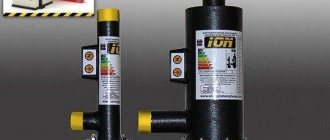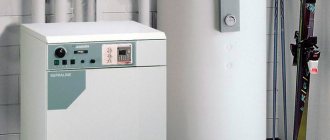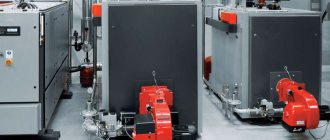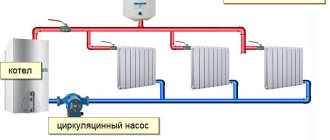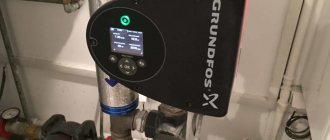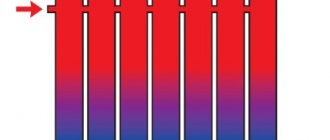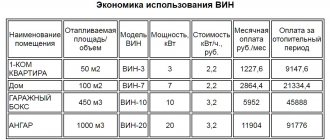Single-pipe horizontal
The simplest version of a single-pipe horizontal heating system with a bottom connection.
When creating a heating system for a private house with your own hands, a single-pipe wiring diagram may turn out to be the most profitable and cheapest. It is equally suitable for both one-story and two-story houses. In the case of a one-story house, it looks very simple - the radiators are connected in series to ensure consistent flow of coolant. After the last radiator, the coolant is sent through a solid return pipe to the boiler.
Advantages and disadvantages of the scheme
First, we will look at the main advantages of the scheme:
- ease of implementation;
- excellent option for small houses;
- saving of materials.
A single-pipe horizontal heating circuit is an excellent option for small spaces with a minimum number of rooms.
The scheme is really very simple and understandable, so even a beginner can handle its implementation. It provides for a serial connection of all installed radiators. This is an ideal heating layout for a small private house. For example, if this is a one-room or two-room house, then “fencing” a more complex two-pipe system does not make much sense.
Looking at the photo of such a circuit, we can note that the return pipe here is solid, it does not pass through the radiators. Therefore, this scheme is more economical in terms of material consumption. If you don’t have extra money, this type of wiring will be the most optimal for you - it will save money and allow you to provide heat to your home.
As for the shortcomings, there are few of them. The main disadvantage is that the last radiator in the house will be colder than the very first one. This is due to the sequential passage of the coolant through the batteries, where it releases the accumulated heat into the atmosphere. Another disadvantage of a single-pipe horizontal circuit is that if one battery fails, the entire system will have to be turned off at once.
Despite certain disadvantages, this heating scheme continues to be used in many small private houses.
Features of installation of a single-pipe horizontal system
When creating water heating for a private house with your own hands, the scheme with single-pipe horizontal wiring will be the easiest to implement. During the installation process, it is necessary to mount the heating radiators, and then connect them with pipe sections. After connecting the very last radiator, it is necessary to turn the system in the opposite direction - it is advisable that the outlet pipe runs along the opposite wall.
A single-pipe horizontal heating circuit can also be used in two-story houses; each floor here is connected in parallel.
The larger your home, the more windows it has and the more radiators it has. Accordingly, heat losses also increase, as a result of which the last rooms become noticeably cooler. You can compensate for the temperature drop by increasing the number of sections on the latest radiators. But it is best to install a system with bypasses or with forced circulation of the coolant - we will talk about this a little later.
A similar heating scheme can be used to heat two-story houses. To do this, two chains of radiators are created (on the first and second floors), which are connected in parallel to each other. There is only one return pipe in this battery connection diagram; it starts from the last radiator on the first floor. The return pipe coming down from the second floor is also connected there.
Forced circulation heating system
The coolant circulation is carried out using a circulation pump. This solves the problem of low return temperature by adding hot water from the supply line. More comfortable heating conditions are also achieved thanks to the ability to adjust the temperature in heating devices. However, there are also significant disadvantages:
- The likelihood of overheating increases if the heating devices in the room are set to low heat consumption.
- If there is no power supply, the circulation pump will no longer be able to perform its function, and therefore the movement of the coolant will stop. This can also lead to overheating.
For example, in order to reduce the risk of an emergency increase in temperature in the heating system, Trayan solid fuel pyrolysis heating boilers are equipped with external or built-in emergency heat exchangers.
The inclusion of storage tanks in the piping scheme allows you to accumulate excess heat and release it into the heating system as needed. This solves several problems:
- In case of low heat consumption, excess hot coolant is accumulated for later use.
- With low heat consumption, the solid fuel boiler still operates at rated power.
- Allows the use of higher power devices.
The figure shows the wiring of a solid fuel boiler with a heat accumulator and a circulation pump:
Photo 4: Piping according to the forced circulation scheme
Many owners of private houses designing a heating system are interested in the question: is it possible to piping a solid fuel boiler with polypropylene? The use of polypropylene pipes imposes certain requirements on the temperature of the coolant. Experts advise that when using polypropylene pipes in a heating system, the first 1-1.5 meters of the supply line should be made of metal, and also use a larger pipe diameter and a thermostatic valve. Naturally, overheating of a solid fuel boiler should be avoided in every possible way.
Features of connecting solid fuel boilers
Boilers of this type do not have the function of regulating the heat supply. The combustion of fuel cannot be interrupted, therefore, in the event of a power outage, the pump responsible for the forced movement of the coolant will stop. However, heating will continue and pressure will increase. The developing process will disable the entire system . To eliminate such moments, several types of emergency circuits are provided that allow you to dump excess heat. This:
- Timely supply of cold water.
- Connecting batteries to the pump.
- Presence of a gravity circuit.
- Additional emergency circuit.
For solid fuel boilers, the piping plays an important role - a high-quality connection will allow you to create a self-regulating system. Therefore, it is better to entrust the subtleties of installation to the skillful hands of specialists.
Gravity heating
It is necessary to pay attention to the principles of coolant circulation through the heating circuit. This is gravitational - the natural movement of the coolant and a forced circulation circuit.
A distinctive feature of these types is the presence or absence of a unit that forces hot water to move. In a natural circulation system, movement in a closed system occurs under the influence of the laws of physics. The process is determined by the difference in water density. This type of heating eliminates the consumption of electricity.
A system with natural circulation cannot be automatically regulated , and this will require pipes with a large diameter, which will affect the interior of the room and increase the cost. If the network is subject to periodic voltage drops, this type of heating arrangement would be the best option. The system is reliable in operation and does not require attention. The natural movement pattern is suitable for a small area, although currently considered "last century".
Advantages of a natural circulation system:
- Easy to install.
- Independence from electricity supply.
- Budget option.
- Reliable operation and operation.
Forced heating system
Forced circulation ensures the creation of the necessary pressure due to the operation of electric pumps . The forced circulation circuit is comfortable because it is controlled automatically provided there is a stable power supply. For each room, it is possible to select separate temperature parameters controlled by system sensors.
Disadvantages of the system:
- Complex strapping scheme.
- Inevitable balancing of parts.
- Expensive service.
- High cost of components.
Any installation system requires a certain number of additional parts. The installation option on primary-secondary rings does not imply a large presence of fastening and connection elements, but instead of them, installation of pumps on heating rings will be required. The system, consisting of rings, together with the floor-standing boiler, is complemented by combs - heating manifolds , which evenly distribute the supply of coolant to the heating elements.
Electric boilers
It must be said that electric heating is the most efficient of all existing ones. Not only are the efficiency of boilers about 99%, but in addition they do not require chimneys or ventilation. There is practically no maintenance of the units as such, except for cleaning once every 2-3 years. And most importantly: equipment and installation are very cheap, and the degree of automation can be any. The boiler simply does not need your attention.
No matter how pleasant the advantages of an electric boiler are, the main disadvantage is just as significant - the price of electricity. Even if you use a multi-tariff electricity meter, you will not be able to beat a wood-burning heat generator in terms of this indicator. This is the price to pay for comfort, reliability and high efficiency. Well, the second disadvantage is the lack of the necessary electrical power on the supply networks. Such an annoying nuisance can immediately cancel out all thoughts about electric heating.
General installation instructions
Before purchasing a heating unit, you need to determine where it will be installed. The furnace room is designed for this, but often there is not enough free space in it, since it is occupied by an existing gas or other heater. Then the installation of a solid fuel boiler in a private house can be done behind the wall of the furnace room, in an extension. A frame made of metal structures is installed and covered with sandwich panels or profiled sheets with insulation. This option is convenient for those who plan to burn with coal; there will be no dirt inside the house.
All inexpensive solid fuel boilers for low-power homes can be placed directly on the rough floor screed. They are light in weight and do not exert vibration loads on the base, since they are not equipped with a fan or screw conveyor for feeding pellets. For units with a power of over 50 kW, it is recommended to build a concrete foundation, which should rest on the ground and compacted crushed stone bedding. The foundation is made 80-100 mm above the level of the screed, and it should not be connected to it. Foundation devices also require long-burning boilers, which have a mechanism for lifting and lowering heavy loads.
Projects for private houses usually provide for the installation of a chimney shaft in the thickness of the wall with a pipe exiting through the roof. If the shaft is missing or occupied by an existing gas heater, you will need to install a chimney for a solid fuel boiler. To do this, it is better to use metal double-walled chimneys with insulation. They are lightweight, assembled from sections of the required length and are easily attached to the wall of the house. For turns and branches, the same double-walled tees and bends are made. Methods for installing chimneys with and without an exhaust shaft can be seen in the figure.
Chimney installation
The furnace room must have natural exhaust ventilation. When heating boilers are installed in a private house, the exhaust is provided through a shaft in the wall. The shaft is parallel to the chimney, only with a smaller cross-section. If it is not available, a transfer grille is installed in the outer wall; it should be located under the ceiling of the room. The role of the hood is as follows:
- A vacuum is created in the furnace room, as a result of which fresh air from other rooms is sucked in and used for combustion. Boiler systems with a power of 50 kW and above require the organization of separate supply ventilation.
- Removing combustion products that accidentally entered the room.
The approximate layout of the equipment and the installation diagram of a solid fuel heating boiler are shown in the figure.
Solid fuel boiler installation diagram
Often in boiler rooms of country houses there is no sewerage outlet. This is not entirely correct, since sometimes it is necessary to empty the system or the water jacket of the boiler. The safety valve discharge is directed into the same drain.
Installation procedure
To perform the work, the following instructions for installing solid fuel boilers are proposed:
- Release the product from its original packaging.
- If there is not enough space in the furnace room, then it is better to assemble the product outside. Install all doors and ash pan drawer, as well as other elements supplied separately. There is no need to install a fan and automation devices; this is done after installing the boiler.
- Move the unit indoors and install it on the foundation or floor so that the gas outlet pipe is on the same axis with the chimney pipe. At home, installing a solid fuel boiler yourself must be done with an assistant; the weight of the equipment is rarely less than 50 kg.
- Secure the boiler to the foundation or screed so that there are no distortions.
- Connect the chimney, install a fan with a control unit and a safety group.
- Connect the boiler to the heating system according to the selected scheme.
Boiler connection
It should be noted that the wiring of gas, diesel and electric heat generators is almost the same. Here we must take into account that the vast majority of wall-mounted boilers are equipped with a built-in circulation pump, and many models are equipped with an expansion tank. First, let's look at the connection diagram for a simple gas or diesel unit:
The figure shows a diagram of a closed system with a membrane expansion tank and forced circulation. This tying method is the most common. The pump with a bypass line and a sump tank is located on the return line, and there is also an expansion tank there. The pressure is controlled using pressure gauges, and air is removed from the boiler circuit through an automatic air vent.
When the heat generator is equipped with its own pump, as well as a circuit for heating water for domestic hot water needs, the pipe layout and installation of elements is as follows:
Shown here is a wall-mounted boiler with forced air injection into a closed combustion chamber. To remove flue gases, a double-walled coaxial flue is used, which is led out horizontally through the wall. If the firebox of the unit is open, then you need a traditional chimney with good natural draft. How to properly install a chimney pipe made of sandwich modules is shown in the figure:
In country houses with a large area, it is often necessary to connect a boiler with several heating circuits - a radiator, heated floors and an indirect heating boiler for DHW needs. In such a situation, the optimal solution would be to use a hydraulic separator. It will allow you to organize independent circulation of coolant in the boiler circuit and at the same time serve as a distribution comb for the remaining branches. Then the basic heating diagram for a two-story house will look like this:
According to this scheme, each heating circuit has its own pump, thanks to which it operates independently of the others. Since coolant with a temperature of no more than 45 ° C should be supplied to heated floors, three-way valves are used on these branches. They add hot water from the main line when the temperature of the coolant in the heated floor circuits drops.
With solid fuel heat generators the situation is more complicated. Their strapping should take into account 2 points:
- possible overheating due to the inertia of the unit; the firewood cannot be extinguished quickly;
- formation of condensation when cold water enters the boiler tank from the network.
To avoid overheating and possible boiling, the circulation pump is always placed on the return side, and on the supply side there should be a safety group located immediately behind the heat generator. It consists of three elements: a pressure gauge, an automatic air vent and a safety valve. The presence of the latter is crucial; it is the valve that will relieve excess pressure when the coolant overheats. If you decide to heat your house with wood, then the following wiring diagram is required:
Here, a bypass and a three-way valve protect the furnace of the unit from condensation. The valve will not allow water from the system into the small circuit until the temperature in it reaches 55 °C. Detailed information on this issue can be obtained by watching the video:
Many homeowners install two different heat sources in the furnace room. They must be properly tied and connected to the system. For this case, we offer 2 schemes, one of them is for a solid fuel and an electric boiler working together with radiator heating.
The second scheme combines a gas and wood heat generator, supplying heat to heat the house and prepare water for hot water supply:
Types of schemes
It is necessary to study the types of techniques before properly tying up a heating boiler. The design may differ depending on the type of unit and the method of organizing the flow. Heating circuits are mounted closed and open. The circulation of the energy carrier can be forced or gravitational. With the open method, an expansion tank is installed without a top cover. It combines several functions:
- allows you to compensate for evaporated water by topping up;
- regulates the volume of energy carrier in case of overheating, accommodating excess;
- removes air pockets if the device is installed with a uniform slope from the tank to the heat exchanger of the unit.
A pump is not required for operation, so the circuit operates silently.
In this video you will learn how to connect the boiler:
With the closed method, there is no communication with the atmosphere, and the circuit operates under pressure. The problem with the design is that when overheated, the pressure increases, so pipes or devices may rupture. An important element of the system is the membrane expansion tank, which protects the circuit from water hammer. It is made of durable metal to withstand pressure.
The design has two pockets, looped one to the other and separated by a rubber heat-resistant partition. In the first the coolant moves, and in the second there is a little gas (nitrogen or accumulated air). The water heats up, enters the expansion tank and penetrates the membrane. After cooling, the gas pushes the mass back into the system. For heating according to this scheme, polypropylene or metal pipes are used.
There are several methods for piping a boiler
Differences between open and closed methods
Before choosing a heating option, you need to know some of the features of the two designs. In open and closed circuits, the expansion tank is located differently. There are other distinctive features as well. They are as follows:
- in the open version, the tank is placed in the highest area of the circuit, and in the closed method there are no strict restrictions on the placement of this element; it can be embedded next to the generator or made wall-mounted;
- in a closed volume, due to the lack of contact with air, the service life of contour elements is extended;
- additional pressure in a closed circuit eliminates air stagnation and pushes plugs to the outlet;
- in an open ring, pipes are placed at a slope to create a natural current, which is inconvenient in some cases;
- it is necessary to take into account the lifting height, narrowing areas, detours and turns, connection points with open heating;
- the collector diameter in an open piping is always larger than in a closed system, thick pipes are difficult to hide in the interior, constant monitoring of the liquid level due to evaporation is required;
- in a closed circuit, you have to choose a place to install the pump in order to reduce the amount of noise during operation.
Gravitational circulation
The coolant moves naturally in the devices, and when it enters the circuit, a forced action is activated.
In the closed version, the movement of the water flow follows physical laws and is determined by the different densities of the hot and cooled energy carrier. This does not use electricity and there is no automatic adjustment device. The scheme is often developed for small buildings. In the open-type gravity concept, the piping of any solid fuel unit includes:
- a collector for accelerating water in the area directly after the boiler;
- an open expansion tank, the volume of which is equal to 10% of the circuit capacity;
- shut-off screws at the outlet and inlet to shut off the heat exchanger during repairs; for this there is no need to drain the energy carrier.
The expansion tank is placed in the upper area after the collector. It has a tap for filling the system with water, and a screw is mounted below to drain the energy carrier. The boiler is placed in the lower area of the circuit. The height difference ensures the movement of water by gravity.
Before winding you need to know about gravitational circulation
Compulsory system
The method provides the required pressure using electric pumps. A circuit of this type is convenient to use, since the control is automated with a constant supply of energy and allows you to set the temperature separately for each room. With a properly arranged boiler room piping scheme, the following benefits are obtained:
- rapid heating of water in all heating devices;
- energy saving;
- the ability to organize underfloor heating due to operational efficiency.
According to the heating boiler piping scheme, the pump is located in front of the unit in the direction of water movement, heating at this point is minimal. The pump is installed parallel to the spill area. A ball valve or check valve with low resistance is mounted between the tapping points.
Proper tying will have several benefits.
While the pump is operating, the piping between the taps is closed. After the supply is completed, the ball valve is again in the operating position and the heating system operates according to the gravitational principle. The method has some disadvantages:
- complexity of the design;
- mandatory balancing of elements;
- periodic maintenance and repairs are expensive;
- the price of spare parts is high.
Number of circuits
In heating boiler schemes with additional hot water connection, the unit is connected to a moisture supply system for domestic use. But a single-circuit generator can also heat the liquid if a secondary heat converter is introduced into the design. Most often, a stainless steel metal canister with a supply pipe is installed.
The single-circuit unit has a simple principle of operation. Natural draft is required for operation, so during installation it is attached to the chimney. The boiler is placed in the service block, because ambient air is used during operation. Such actions will prevent an explosion and maintain safety for people living in a private building.
A dual-circuit device differs in the number of functions it performs. It simultaneously maintains the temperature of the water in the system and heats the liquid in the tank for domestic use after the energy carrier comes into contact with the secondary heat exchanger. Heat is given off directly; when boiling water is removed, the energy carrier does not heat up, and simultaneous operation of two lines is impossible.
To obtain a large volume of heated water, columns and a single-circuit circuit are combined. A double-circuit device is not used in designs with natural movement of water. When heating is stopped, the liquid cools quickly, and subsequent heating takes a long time.
Features of piping circulation pumps
Pump piping
The pump in the heating system is necessary for stable circulation of the coolant, which would not depend on the degree of expansion of the water. It is installed according to the scheme at the point with the lowest water temperature - before it enters for reheating into the boiler.
The piping of the circulation pump of the heating system consists of two parallel heating circuits. This is necessary to ensure the smooth flow of hot water during a power outage. If this is not done, the resistance from the fixed impeller will worsen the already unsatisfactory performance of natural circulation.
In practice, the following components must be included in the piping of the heating system circulation pump:
- Shut-off valves. With its help, the flow of water into a certain section of the main line is blocked - main or auxiliary;
- Mesh filter. Necessary to protect the impeller and pump rotor from rust particles or sediment from the surface of the pipes. It is a mandatory component in the piping of the heating system pump, installed in front of it in the direction of the coolant flow;
- Check valve on auxiliary line. With natural circulation, the phenomenon of changing the direction of movement of hot water is possible. To prevent this, be sure to install a check valve in the heating pump piping.
These are the main components of the circulation pump piping in heating systems. If you need to install an additional one, you should purchase a synchronizer for stable operation of the pumps. It will synchronize the rotation speed of the impellers, thereby minimizing the possibility of water hammer and periodic pressure changes in the heating system.
Polypropylene pipes in heating systems
Fittings and pipes made of polypropylene (PPR) are popular due to their low cost and ease of installation. They are not subject to corrosion, have smooth internal walls and serve no less than the 50 years declared by the manufacturer.
There are several types of these pipe products, which differ in technical characteristics and purpose.
In the construction of heating systems, as well as in the installation of hot water supply circuits similar to them in operational parameters, the following is used:
- Pipes marked PN 25. Products with reinforcement made of aluminum foil. Used in systems with nominal pressure up to 2.5 MPa. Operating temperature limit +95º C.
- Pipes marked PN 20. Reinforced version used in DHW branches of double-circuit heating boilers. They will work for the period stated by the manufacturer if the coolant temperature is not higher than +80º C and the pressure is not higher than 2 MPa.
- Pipes marked PN 10. Thin-walled polymer products. They are used if the boiler supplies coolant to the water heated floor system. Operating temperature not higher than +45º C, nominal pressure up to 1 MPa.
Polymer pipes are suitable for all known installation methods: open and hidden. But this material has a high coefficient of thermal expansion. When heated, such products begin to slightly increase in length. This effect is called thermal linear expansion and must be taken into account when constructing pipelines.
The boiler should be tied with polypropylene pipes, which are marked as operating class 5, operating pressure of 4–6 atmospheres and nominal pressure PN of 25 and above
To prevent destruction of polypropylene heating pipelines, compensation loops can be installed. But it’s easier to take multilayer pipes, the reinforcement in which is specifically designed to compensate for this stretching. A layer of foil inside PN 25 polypropylene pipes reduces their thermal elongation by half, and fiberglass by five times.
Two-pipe system with top wiring
In a two-pipe heating system with overhead wiring, the expansion tank is placed at the highest point.
This two-pipe scheme is very similar to the previous one, only here it is provided for the installation of an expansion tank in the very top part of the system, for example, in an insulated attic or under the ceiling. From there, the coolant goes down to the radiators, gives them part of its heat, and then is sent through the return pipe to the heating boiler.
Why is such a scheme needed? It is optimal in multi-storey buildings with a large number of radiators. Thanks to this, more uniform heating is achieved, and there is no need to install a large number of air vents - the air will be removed through the expansion tank or through a separate bleeder that is part of the safety group.
Advantages and disadvantages of a two-pipe system with top wiring
There are a lot of positive features:
- it is possible to heat multi-storey buildings;
- saving on air vents;
- you can create a system with natural coolant circulation.
There are also some disadvantages:
Using vertical wiring will lead to additional difficulties when installing hidden heating.
- pipes are visible everywhere - this scheme is not suitable for interiors with expensive finishing, where elements of heating systems are usually hidden;
- in tall buildings it is necessary to resort to forced circulation of the coolant.
Despite the disadvantages, the scheme remains quite popular and widespread.
Features of installation of two-pipe systems with top wiring
This scheme eliminates the need to locate the heating boiler at the lowest point. Immediately after the boiler, the supply pipe is diverted upward, and an expansion tank is installed at the highest point. Coolant is supplied to the radiators from above, so a lateral or diagonal radiator connection scheme is used here. After this, the cooled coolant is sent to the return pipe.
Mandatory elements of the heating system
To control the pressure in the pipeline and equipment, a pressure gauge must be installed. Air can get into the system, it will interfere with productive work, so you can get rid of such nuances by using an automatic air vent.
An emergency relief valve must be installed; excessive pressure without taking any measures will negatively affect the connections, unit and heating devices. The operating principle of this component is simple: part of the coolant is drained into the sewer pipe, thereby eliminating the unpleasant phenomenon.
Another important detail in the piping of a gas boiler is the expansion tank; it is able to compensate for thermal expansion and prevent water hammer. The device is installed at the highest point of the line; if the heating system is closed, then the installation of a circulation pump will be required.
This element is also in demand for drawings with forced and natural circulation; the container looks quite simple, but it can protect the device from many excesses.
What does the heating boiler piping consist of?
Knowing what the boiler piping should do, we can easily guess what is included in its composition and select the appropriate equipment. Such equipment is located directly next to the boiler (on the walls and floor of the boiler room) and on it:
1 - filter; 2 - circulation pump; 3 - ball valves; 4 - expansion tank; 5 - boiler; 6 — pressure gauge; 7 — air vent; 8 - safety valve; 9 - system refill-drain unit
Let's look at the piping, starting with the return line.
1. The coolant approaches the circulation pump and enters the filter:
- which stands in front of (!) the pump.
2. The pump, as can be seen from the diagram, is located in front of the boiler. There are ball valves on both sides of the pump so that you can change the pump or clean the filter without draining the coolant from the entire system. Replacing the pump is quite simple, since it is secured with union nuts.
In general, the main requirement when installing a boiler is to provide fairly easy access to the pump and other piping elements.
3. There is an expansion tank between the pump and the boiler. The expansion tank can be installed anywhere in the system, but it is preferable as shown in the diagram.
4. Then the coolant enters the boiler, heats up and enters the supply pipe.
5. At the boiler outlet, a safety group is required: automatic air vent + safety valve + pressure gauge. The boiler may also have a thermometer to monitor the temperature in the boiler.
6. A ball valve with a fitting on which you can attach a hose and feed the system from the water supply. Or drain the coolant from the system.
The above are mandatory elements that must be included in the boiler piping.
The wall-mounted boiler has all the same devices, only they are already inside the housing.
If you are not familiar with any of the listed equipment, you can find complete information about it in the section on heating equipment.
Elements of piping of a floor-standing boiler
Let's consider what elements the piping of a floor-standing gas heating boiler may include.
Expansion tank
A membrane expansion tank is necessary to compensate for the increased volume of water or antifreeze when they are heated. This element is divided by a membrane into two parts, one of them is filled with air or nitrogen. As the volume of coolant increases, the gas is compressed, so the pressure in the heat exchanger does not increase significantly.
Note! The volume of the expansion tank must be at least 10% of the amount of coolant.
Safety valve
The purpose of the safety valve is to relieve excess coolant when there is a large increase in pressure in the circuit in order to prevent rupture of heating system pipes. Excess liquid is discharged through the drainage tube into the sewer system. If the valve operates frequently, this indicates that the expansion tank is not of sufficient size.
Pressure gauge
A pressure gauge is needed to monitor the operating pressure in the circuit. Sometimes a thermomanometer is used instead, which measures not only pressure, but also temperature. The scale of such a device should reach at least 4 atmospheres.
Air vent
The air vent is designed to release air masses that remain after draining the coolant into the environment. The remaining air creates noise and acts as an obstacle to the normal circulation of the coolant.
Circulation pump
The pump circulates the coolant forcibly. Its power can be changed, thereby regulating the speed of fluid flow in the heat exchanger.
Indirect heating boiler
A boiler is necessary to provide hot water in the required volume. It is a heat-insulating tank in which heated water is stored.
Hydroarrow
A hydraulic arrow is a container with pipes to which you can connect several circuits that combine supply and return. This element allows you to connect pipes in which the liquid has different circulation rates and temperatures.
Coarse filter
This element is a reservoir with a filter mesh to purify water from large debris. The filter protects the heat exchanger tube from clogging.
Pipes
Many people are interested in the question of what pipes can be used for piping a floor-standing gas boiler. The temperature in the circuit usually does not exceed 80°C, and in the underfloor heating system it does not exceed 35°C. The pressure is at the level of 1-2.5 kgf/cm2. When the pump is stopped, boiling of the coolant is prevented, since after a few seconds the burner stops working and the flame goes out. Based on the existing operating conditions, polymer and metal-polymer pipes, the cost of which is much lower than durable copper or galvanized analogues, are quite suitable for piping a floor-standing gas heating boiler.
Which floor-standing gas boilers are better - with a built-in or indirect boiler? Read here the general requirements for the installation and connection of gas boilers. How to connect a wall-mounted gas boiler?
Single-circuit and double-circuit heating boiler.
A single-circuit boiler has a fairly simple operating principle. During installation, it is connected to the chimney. For the normal functioning of the system, the presence of normal natural draft is sufficient.
Often, single-circuit boilers are installed, which in their design have an open combustion chamber, which requires the creation of certain conditions in the room.
During its operation, the boiler uses air from the room. That is why it should be installed in a separate room. It is worth noting that when a single-circuit boiler operates, substances and gases harmful to the human body accumulate, this is the main reason for the need to equip a room with a boiler with a chimney or hood. If all the above conditions are created, the risk of explosion will be eliminated and will also ensure the safe use of the equipment.
A double-circuit heating boiler differs from a single-circuit analogue in its universal purpose: it maintains the degree of coolant in the heating circuit and heats water for domestic needs. Single-circuit generators can also indirectly heat water. The heat transfer process is carried out during the passage of the coolant through the secondary heat exchanger.
The main difference between a double-circuit boiler and a single-circuit boiler is the direct transfer of thermal energy to water. The main feature is that when hot water is consumed, the coolant is not subject to heating, and parallel operation of two circuits is excluded. Practice shows that the operating mode of the boiler is not important for houses with high-quality thermal insulation, it follows that with thermal inertia, the heating circuit will be the same for any type of heating. An impressive volume of hot water can be obtained by combining a single-circuit design and heating columns.
A double-circuit boiler should not be designed in combination with a natural circulation system, since after heating of the coolant stops, the movement of the liquid quickly stops. The secondary heating process takes quite a long time, and the heat in the radiator is distributed unevenly.
The main advantage of the scheme is the ability to operate in natural circulation mode. The booster of the collector in this case is a pipe through which the coolant moves to the upper filling.
Tying gas boilers with polypropylene
The boiler piping is carried out using the soldering method - this will completely eliminate leaks that usually occur due to inaccurately installed fittings.
An advantage of working with a polypropylene pipeline will be the ability to create any circuit. For amateurs, a simple strapping scheme will be sufficient. Different technologies for welding polypropylene and working with fittings adjusted in size are acceptable. A large number of connections should be avoided, and the possibility of smooth transitions should not be neglected. An indispensable condition is a rigid connection at the gas supply to the boiler. A metal pipe and a connection to the unit using an “American” or a drive are recommended. This is the main condition when working with gas boilers.
A paronite gasket will do. The use of tow, fum tape and rubber components is prohibited. They can catch fire, and the rubber will reduce the diameter of the pipe, which will disrupt the gas supply. Such a pipeline initially claims to have a long service life , capable of withstanding pressure exceeding 25 bar and a coolant of 95 degrees.
Recommendations for choosing and connecting radiators
An ordinary homeowner, going to a heating equipment store and seeing a wide selection of different radiators there, can conclude that choosing batteries for his home is not so easy. But this is the first impression; in fact, there are not so many varieties of them:
- aluminum;
- bimetallic;
- steel panel and tubular;
- cast iron
Sectional batteries made of aluminum alloy have the best heat transfer rates; bimetallic heaters are not far behind them. The difference between the two is that the former are made entirely of alloy, while the latter have a tubular steel frame inside. This was done for the purpose of using the devices in centralized heat supply systems of high-rise buildings, where the pressure can be quite high. Therefore, installing bimetallic radiators in a private cottage makes no sense at all.
It should be noted that heating installation in a private home will be cheaper if you purchase steel panel radiators. Yes, their heat transfer rates are lower than those of aluminum ones, but in practice you are unlikely to feel the difference. As for reliability and durability, the devices will successfully serve you for at least 20 years, or even more. In turn, tubular batteries are much more expensive, in this respect they are closer to designer ones.
Steel and aluminum heating devices have one useful quality in common: they lend themselves well to automatic control using thermostatic valves. The same cannot be said about massive cast iron batteries, on which it is pointless to install such valves. This is due to the ability of cast iron to heat up for a long time and then retain heat for some time. Also because of this, the rate of heating of the premises is reduced.
If we touch on the issue of appearance aesthetics, then the cast-iron retro radiators currently offered are much more beautiful than any other batteries. But they also cost incredible amounts of money, and inexpensive Soviet-style accordions MS-140 are only suitable for a one-story country house. From the above, the conclusion suggests itself:

